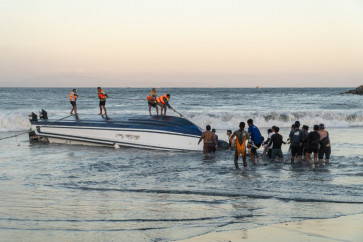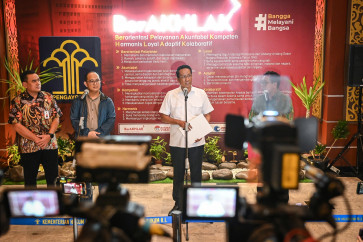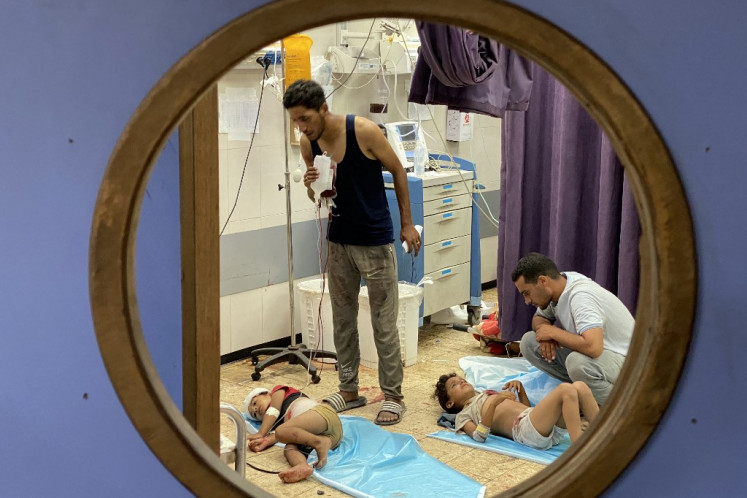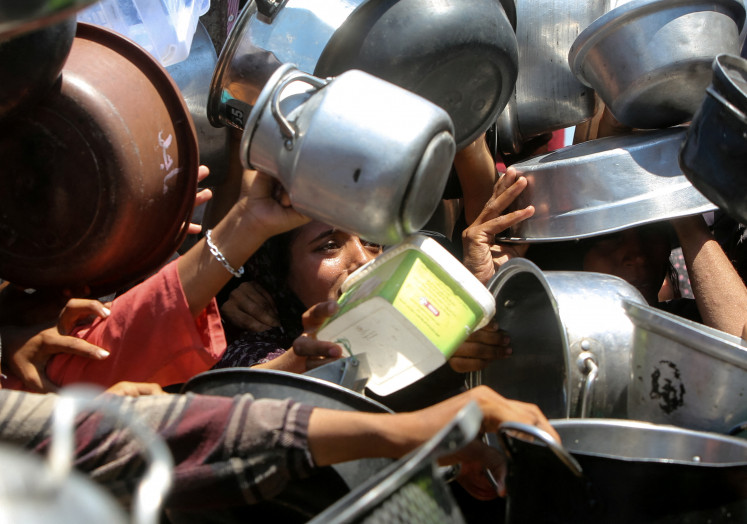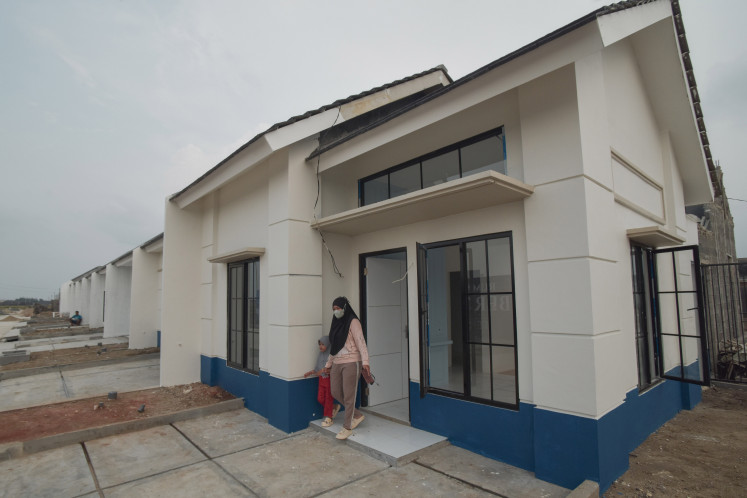Popular Reads
Top Results
Can't find what you're looking for?
View all search resultsPopular Reads
Top Results
Can't find what you're looking for?
View all search resultsArt affairs between the king & painter
Memorable: King Bhumibol Adulyadej (left) talks with Basoeki Abdullah
Change text size
Gift Premium Articles
to Anyone
Memorable: King Bhumibol Adulyadej (left) talks with Basoeki Abdullah.
The story of a friendship between Indonesia’s greatest painter, Basoeki Abdullah, and the late Thai King Bhumibol Adulyadej.
The beloved King Bhumibol Adulyadej, who passed away last month, turned out to have felt affection for Indonesia. The king had forged a decades-old friendship with Indonesian painter Basoeki Abdullah.
“For decades I admired Indonesia through Basoeki Abdullah, the painter who became a cultural envoy in my palace,” said Bhumibol.
The story of a beautiful friendship between the painter and the king began when King Bhumibol invited Basoeki to Thailand to paint him and the royal family. The King’s aides, Surathun and Tan Puying Manilat, from the Thai kingdom delivered the invitation to Basoeki when he opened his solo exhibition in Singapore in 1958.
During the display Surathun invited Basoeki to Bangkok to paint the portraits of King Bhumibol, Queen Mon Raachawong Sirikit and their family and relatives at Popporo Palace as the main part of the Cakri palace group within the Grand Palace complex, which was the official residence of the King.
Basoeki at first objected due to exhaustion after serving Singapore and Indonesian collectors. But Surathun insisted he visit by referring to the cultural origin shared by Indonesia and Thailand with their former Buddhist tradition, and so Basoeki finally consented.
In Thailand, Basoeki was warmly welcomed by the King and Queen and all his requests were fulfilled, including a solo display in Bangkok, which was meant to introduce himself to the people of Thailand.
Basoeki began his task as an official painter of Popporo Palace. His main job was to paint the whole royal family based on the family tree, the living and the deceased. His second job was to enhance the esthetic dignity of palace decorations. Before long, King Bhumibol was gratified by Basoeki’s performance. He prepared a comfortable residence for Basoeki in the Ekkamai zone in Bangkok and a stylish studio beside Chitralada Palace. For his reputation, Basoeki even earned an honorary title: Basedi.
“I was eventually captivated by Thailand. My heart was so close to Bhumibol, a considerate, friendly and modest figure,” said Basoeki.
On the other hand, the King was also happy to have known the painter from Surakarta, Central Java. For the King, Basoeki was the most entertaining actor during leisure time. Therefore, he frequently visited Basoeki’s studio and also liked showing the studio to his guests.
One memorable story occurred when the King took several guests to inspect unique palace rooms. When they reached Basoeki’s studio room, he opened the door gently to create a surprise effect. The King was convinced that the painter would be stroking with his brush. What he found was beyond unexpected. Basoeki wasn’t facing a canvas. He was on a sofa with a blanket shrouding his entire body except his face, which was covered by a mask of the temple-guard god. The King was taken aback and then he laughed, as did his visitors.
“It is a theater,” said a guest.
“For Basedi, there’s no day without theater. His action is a metaphor. He’s a maestro from Indonesia,” responded the King, heading for another room.
King Bhumibol paid special attention to the life of Basoeki. That’s why when Basoeki covertly married a bartender, the King was angry, thus limiting his access to facilities at Popporo.
But the anger was only short-lived as Basoeki finally divorced and married Nataya Nareerat, Thailand’s beauty queen finalist, whose figure and personality got the King’s “consent”.
Bhumibol and Basoeki were so close that the King felt he could pass his wisdom to him. In mid-1965, Basoeki and Nataya observed strong political, social and cultural frictions in Indonesia, described by president Sukarno as The Year of Vivere Pericoloso (living dangerously).
So, Nataya wanted to buy a plot of land in Bangkok for permanent residence. However, government rule prohibited a foreigner to do so — Nataya became an alien after following Basoeki’s Indonesian citizenship.
To settle the case, an official suggested that Basoeki and Nataya divorce first, so that Nataya could become a Thai citizen and be allowed to buy land. This trick worked. After the land was secured, Basoeki and Nataya remarried on Oct. 22, 1965. Basoeki was surprised when on one occasion the King asked him: Has the land purchase already settled? Basoeki was sure that the trick had come straight from the King.
In March 1967, Basoeki received a letter from BM Diah, Indonesia’s Ambassador to Thailand, requesting Basoeki’s return to Indonesia to paint Soeharto, who had been inaugurated as president.
Basoeki, however, was wary of the mission. “They might have planned to arrest me and make me a political detainee. That’s how it was done. I was accused of being a Sukarnoist,” he said. Basoeki had hid for some time in Thailand as suggested by King Bhumibol.
Bhumibol revealed that his association with Basoeki made him feel intimate with the culture of Southeast Asia. This prompted him to encourage the granting of the annual ASEAN awards for culture and art.
In 1974, Basoeki decided to return to Jakarta. The King felt sad. “I have no choice. But never forget to tell everybody there that Thailand and Indonesia are brothers. They’re like Basedi and I,” concluded King Bhumibol.
— Photo by Agus Dermawan T.

.img_assist_custom-510x384.jpg)

